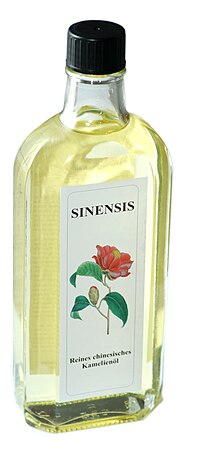
Metabolic Responses of Tea (Camellia sinensis L.) to the Insecticide Thiamethoxam.
Sign Up to like & getrecommendations! Published in 2023 at "Pest management science"
DOI: 10.1002/ps.7534
Abstract: BACKGROUND Thiamethoxam (TMX) is insecticidal, but also can trigger physiological and metabolic reactions of plant cycles. The objective of this work was to evaluate the physiological and metabolic effect of TMX on tea plant and… read more here.
Keywords: responses tea; metabolic responses; tmx; camellia sinensis ... See more keywords

Genomic and pedigree‐based predictive ability for quality traits in tea (Camellia sinensis (L.) O. Kuntze)
Sign Up to like & getrecommendations! Published in 2021 at "Euphytica"
DOI: 10.1007/s10681-021-02774-3
Abstract: Genetic improvement of quality traits in tea (Camellia sinensis (L.) O. Kuntze) through conventional breeding methods has been limited, because tea quality is a difficult and expensive trait to measure. Genomic selection (GS) is suitable… read more here.
Keywords: quality traits; prediction; traits tea; tea camellia ... See more keywords

Polysaccharides from the flowers of tea (Camellia sinensis L.) modulate gut health and ameliorate cyclophosphamide-induced immunosuppression
Sign Up to like & getrecommendations! Published in 2019 at "Journal of Functional Foods"
DOI: 10.1016/j.jff.2019.103470
Abstract: Abstract Polysaccharides are closely related to immune regulation, however, the effects of polysaccharides from different sources may be different. Therefore, the impact of a pectic heteropolysaccharides (TFPS) from the flowers of tea (Camellia sinensis L.)… read more here.
Keywords: camellia sinensis; gut health; flowers tea; cyclophosphamide induced ... See more keywords

Herbivore-Induced (Z)-3-Hexen-1-ol is an Airborne Signal That Promotes Direct and Indirect Defenses in Tea (Camellia sinensis) under Light.
Sign Up to like & getrecommendations! Published in 2021 at "Journal of agricultural and food chemistry"
DOI: 10.1021/acs.jafc.1c04290
Abstract: Tea (Camellia sinensis) is the most popular nonalcoholic beverage worldwide. During cultivation, tea plants are susceptible to herbivores and pathogens, which can seriously affect tea yield and quality. A previous report showed that (Z)-3-hexenol is… read more here.
Keywords: herbivore induced; tea camellia; tea; tea plants ... See more keywords

Heterologous Expression and Characterization of Tea (Camellia sinensis) Polyamine Oxidase Homologs and Their Involvement in Stresses.
Sign Up to like & getrecommendations! Published in 2022 at "Journal of agricultural and food chemistry"
DOI: 10.1021/acs.jafc.2c01549
Abstract: Polyamine oxidase (PAO) is a key enzyme maintaining polyamine homeostasis, which affects plant physiological activities. Until now, the gene members and function of PAOs in tea (Camellia sinenesis) have not been fully identified. Here, through… read more here.
Keywords: polyamine oxidase; tea camellia; tea; expression ... See more keywords

Comparative Transcriptomic Analysis Reveals Regulatory Mechanisms of Theanine Synthesis in Tea (Camellia sinensis) and Oil Tea (Camellia. oleifera) Plants.
Sign Up to like & getrecommendations! Published in 2019 at "Journal of agricultural and food chemistry"
DOI: 10.1021/acs.jafc.9b02295
Abstract: Tea provides a rich taste and has healthy properties due to its variety of bioactive compounds, such as theanine, catechins and caffeine. Theanine is the most abundant free amino acid (40%70%) in tea leaves. Key… read more here.
Keywords: oil tea; tea camellia; regulatory mechanisms; mechanisms theanine ... See more keywords

Increasing temperature changes the flux into the multiple biosynthetic pathways for 2-phenylethanol in model systems of tea (Camellia sinensis) and other plants.
Sign Up to like & getrecommendations! Published in 2019 at "Journal of agricultural and food chemistry"
DOI: 10.1021/acs.jafc.9b03749
Abstract: 2-Phenylethanol (2PE) is a representative aromatic aroma compound in tea (Camellia sinensis) leaves. However, its formation in tea remains unexplored. In our study, feeding experiments of [2H8]L-phenylalanine (Phe), [2H5]phenylpyruvic acid (PPA), or (E/Z)-phenylacetaldoxime (PAOx) showed… read more here.
Keywords: changes flux; tea camellia; phe; increasing temperature ... See more keywords

Potentiality of actinobacteria to combat against biotic and abiotic stresses in tea [Camellia sinensis (L) O. Kuntze]
Sign Up to like & getrecommendations! Published in 2022 at "Journal of Applied Microbiology"
DOI: 10.1111/jam.15734
Abstract: Tea (Camellia sinensis (L) O. Kuntze) is a long‐duration monoculture crop prone to several biotic (fungal diseases and insect pest) and abiotic (nutrient deficiency, drought and salinity) stress that eventually result in extensive annual crop… read more here.
Keywords: camellia sinensis; sinensis kuntze; crop; tea camellia ... See more keywords

Leaf transcriptome analysis of a subtropical evergreen broadleaf plant, wild oil-tea camellia (Camellia oleifera), revealing candidate genes for cold acclimation
Sign Up to like & getrecommendations! Published in 2017 at "BMC Genomics"
DOI: 10.1186/s12864-017-3570-4
Abstract: BackgroundCold tolerance is a key determinant of the geographical distribution range of a plant species and crop production. Cold acclimation can enhance freezing-tolerance of plant species through a period of exposure to low nonfreezing temperatures.… read more here.
Keywords: oil tea; tea camellia; wild oil; camellia ... See more keywords

Characterization of tea leaf metabolites dependent on tea (Camellia sinensis) plant age through 1H NMR-based metabolomics
Sign Up to like & getrecommendations! Published in 2020 at "Applied Biological Chemistry"
DOI: 10.1186/s13765-020-0492-7
Abstract: The chemical or metabolic compositions of tea (Camellia sinensis) varies according to numerous factors, such as geographical origin, cultivar, climate, plucking position, and horticultural practices. However, how the age of tea plants affects the metabolite… read more here.
Keywords: tea leaf; age; tea camellia; tea ... See more keywords

Identification and characterization of phenolamides in tea (Camellia sinensis) flowers using ultra-high-performance liquid chromatography/Q-Exactive orbitrap mass spectrometry.
Sign Up to like & getrecommendations! Published in 2023 at "Food chemistry"
DOI: 10.2139/ssrn.4383280
Abstract: Phenolamides (PAs) are important secondary metabolites present in plants with multiple bioactivities. This study aims to comprehensively identify and characterize PAs in tea (Camellia sinensis) flowers using ultra-high-performance liquid chromatography/Q-Exactive orbitrap mass spectrometry based on… read more here.
Keywords: tea camellia; flowers using; camellia sinensis; sinensis flowers ... See more keywords